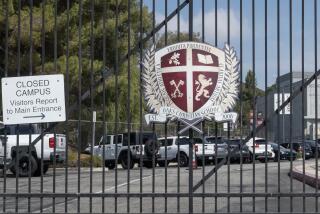Ex-student’s persistence ended school’s day of Latino caricatures
He remembered classmates in huge sombreros and fake mustaches, and dressed as Border Patrol and immigration agents. He was offended seeing Latino culture reduced to caricature during the “Seniores and Señoritas” day for graduating seniors at Anaheim’s Canyon Hills High School.
So the day before it could take place his senior year, he went to see a campus official to lodge his complaint. He left speechless and discouraged.
“Get a sense of humor,” he was told.
Jared Garcia-Kessler, 19, graduated and started studying business at Santiago Canyon College in Orange. He took a Chicano studies class, became energized again, and this time took his complaint to the superintendent and demanded an investigation.
“We are a diverse campus,” he said of his former school, “so for us to hold a day like this, I was beside myself.”
And the probe — a copy of which The Times obtained this week — found that administrators not only ignored Garcia-Kessler’s complaints, but that senior week activity grew even more “extreme” in the year after he graduated. Students showed up at the Anaheim Hills campus dressed as gang members with bandannas and teardrop tattoos, as a pregnant woman pushing a baby stroller and as gardeners.
Michael L. Christensen, superintendent of Orange Unified School District, said in a written statement Thursday that the actions of these students were “demeaning and offensive.”
He added: “The district is committed to working with the staff and students of Canyon High School to ensure a positive school climate and culture in all school activities.”
An internal investigation found that “Seniores and Señoritas”—a play on the word “senior”—dates to at least 2009. As Anaheim has struggled with ethnic and social tension — a result of police shootings and heated debate over the distribution of political power in the majority Latino city — some argue that this may expose broader cultural insensitivities on campus and in the wealthy, majority white enclave of Anaheim Hills.
“They mirror their community, they mirror how they were raised,” said Sammy Rodriguez, a Santiago Canyon College instructor who urged Garcia-Kessler to report his concern. “It’s part of the fabric of that community. And the administration reinforced that, and that’s even worse.”
Diane Singer, a school board member whose district includes Canyon High School, said the district needs to bolster cultural tolerance where she says it’s missing. “It’s not just our school, it’s everywhere, and it needs to be addressed,” she said.
Singer met with Garcia-Kessler before he talked to the superintendent.
“It was painful,” she said of hearing his experience. “It hurt me a lot. I think the portrayal of Mexicans was racist. I’m a Latina. Something like this hurts you to your core, your soul. I know how these students feel.”
Kathryn Moffat, an Orange Unified school board member, said she could understand what led students to complain but believes the activity did not represent a widespread lack of cultural awareness on campus. “I don’t think what this small number of students did is indicative of, or can be extrapolated to represent, the student body,” Moffat said.
Even critics voiced support for solutions proposed by the investigation’s author — Aileen M. Sterling, executive director of secondary education — noting that it could send a powerful message and take steps toward correcting a troubling culture.
The proposals include eliminating “Seniores and Señoritas” day while adding an international week focusing on cultural appreciation, diversity and sensitivity training for Canyon High administrators and an elective ethnic studies course at a community college.
The matter was turned over to the district’s human resources department, although officials cautioned that they cannot disclose any disciplinary actions. Some, however, believe disciplinary action is in order.
“That shows how insensitive this person was,” Singer said of the school official who first downplayed Garcia-Kessler’s concern. “It goes down to their heart — how do you not see this is a problem?”
Garcia-Kessler said he was satisfied with the investigation. “I feel like they were transparent in their findings.”
Rodriguez said any changes will come about because of Garcia-Kessler and his persistence.
“Here you have a hero who steps up to the plate,” Rodriguez said. “He represents a generation that wants to bring about change. He took on the whole establishment and won.”
Despite the initial rebuff, Garcia-Kessler said he pushed the issue — even after he graduated — because of his own background. He is Latino, but identifies with many other cultures as well.
His stepfather is half Italian. His mother is half French Canadian and half Korean, adopted by a half-Irish, half-Norwegian family. His biological father is Mexican.
“I was raised to be accepting.”
More to Read
Sign up for Essential California
The most important California stories and recommendations in your inbox every morning.
You may occasionally receive promotional content from the Los Angeles Times.











